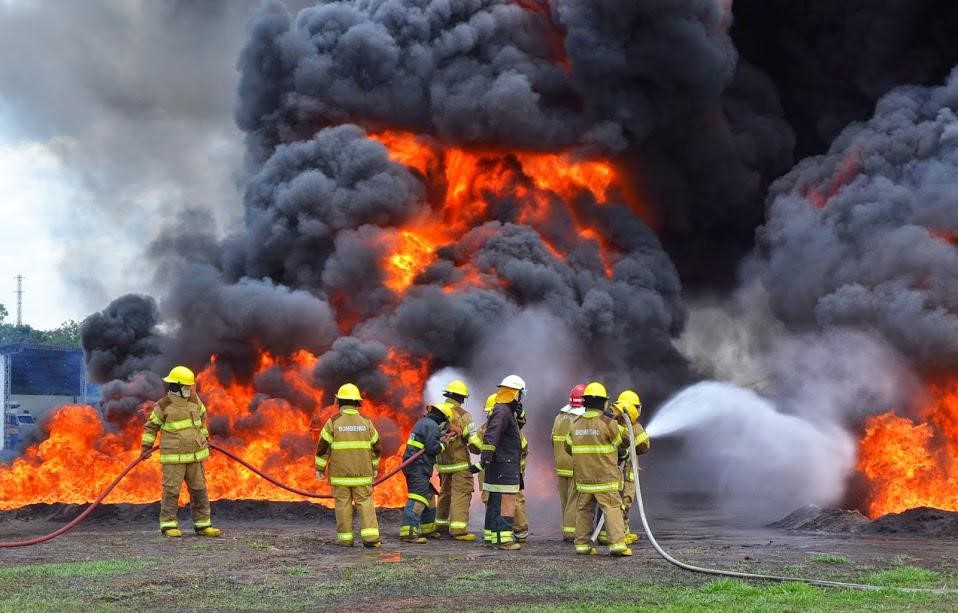Currently, 685 military personnel from the Brazilian Air Force are part of the Brazilian Air Force’s Firefighting System (SISCON) and carry out prevention, rescue and firefighting activities
Agência Força Aérea, por Tenente Marayane Ribeiro E Major Oliveira Lima
Everything seems calm, until the siren rings. The military firefighters are then called and, from then on, the race against time to put out the fire and, above all, to save lives begins. The professionals, who are responsible for the execution of prevention, rescue and firefighting activities in airfields and buildings, have their date remembered on July 2, in allusion to the creation of the Military Firefighter Corps of the Court, in 1856.
The Brazilian Air Force (FAB) currently has 685 military firefighters, distributed among 16 airfields and military units, which are part of the Air Force’s Firefighting Service, implemented in 1967. Since 1980, however, this Service has changed its nomenclature to the Aeronautics Firefighting System (SISCON).
The SISCON has as its Central Organ the Air Force Infrastructure Directorate (DIRINFRA) and operates during 24 hours, with firefighting vehicles, firefighters with individual protection equipment, with the objective of protecting the aircraft that operate in the airfields, safeguarding the crew and the passengers.

News
In recent years, DIRINFRA has implemented several actions, in order to increase the protection of FAB’s airfields and facilities, such as the execution of the maintenance contract for firefighting vehicles, since October 2020. This initiative has increased the operational readiness of the Fire Fighting Cars from 58% to 87%, ensuring the required Fire Protection Level of the Operational Links, as well as the response time in emergency actions required by international standards and protocols.
Another relevant factor was the acquisition of the new extinguishing agent, Liquid Foam Generator (LGE) of “Level C” efficiency, with a proven higher extinguishing power in an aeronautical emergency, a fact that provided a reduction in the use of fire trucks and human resources in occurrences, without affecting the operational safety of our airfields.

Acting
FAB Military Firefighter for seven years, Sergeant Guilherme Alves Bueno Tinoco explained that the team is trained to perform specific procedures for different types of emergencies and aircrafts. In an emergency aircraft, for example, the fire engine is responsible for controlling the flames, through the monitor cannon. In a spot fire, on the other hand, the flames control is done by hose lines, where the Firefighters will perform the cooling and the protection of the aircraft structure, providing the survival of the occupants and, also, in the evacuation of people from the aircraft, assisted by the Rescue Firefighters.
“Finally, after the fire is extinguished, the Rescue Team will also perform the Pre-Hospital Care (APH), through maneuvers and techniques, provided in international and national protocols, performing triage methods, removing hardware or other materials that are on the victims and transporting patients to a safe place, for the proper care of health professionals (Medical Team). Providing all the necessary protection for firefighting and rescuing victims, it is also up to the team to meet, discuss the points made in that emergency, recondition and reorganize the materials and equipment, aiming to provide the reestablishment of fire protection in the airfield, and, in the end, always fulfill their duty: saving lives!”, he highlighted.

According to the military, the activity itself is already a daily challenge, because everything must be done safely, no matter how simple an emergency may be, whether it is an aeronautical emergency or not: “The work requires a routine of hard training, specific equipment, and the use of operational techniques to accomplish our main mission: saving lives! Although it is challenging, it is very rewarding,” said the graduate.
One of the most remarkable episodes for the military man was the fire, in 2018, in the vegetation of the Air Force Academy. “At the time, as the weather conditions favored the expansion of the fire, the Academy’s Prevention, Rescue and Firefighting Service needed to use all available resources, with personnel, material and equipment. It was an event that lasted approximately eight hours, until the place was under control. The exhausting, but rewarding, work of the action left a lasting impression on me,” he recalled.
Training
The aeronautics firefighter sergeant is trained for two years at the Aeronautics Specialists School (EEAR). The other military firefighters are trained in the Military Airfield Firefighter Course (CBAM), which takes place in the Operational Links, and lasts seven weeks.

Photos: SISCON *** Translated by the DEFCONPress Team ***
